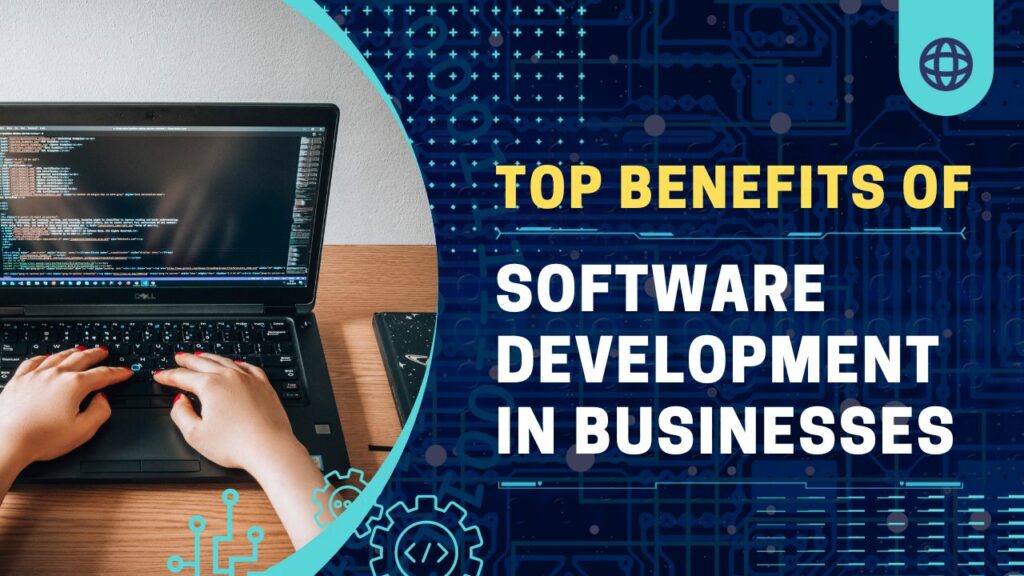In today’s corporate environment, software plays a critical role in boosting businesses. The choice of business software is crucial for firms as they try to stay ahead in the changing digital landscape. Many solutions are available on the market. All of them claim to be the best fit for certain types of business requirements. Finding the three most important aspects to take into account when buying business software is vital in the midst of this plethora. In this piece, we’ll examine the crucial elements that decision-makers should consider when searching for software that not only satisfies present needs but also establishes the groundwork for future expansion and flexibility. In this article, we’ll answer your question, “What are the three most important features to consider when buying business software?”
Why do you need a business software?
With the use of business management software, staff members can access and manage multiple tasks in a single place. They can work on assignments and projects, and monitor advancement all from one single location. This centralized method ensures a seamless flow of work across departments by doing away with the need for email chains, manual handoffs, and separate platforms. Investing in new software for your company is crucial. The platform you and your team select can improve productivity, automate labor-intensive chores, and streamline business processes—all of which can result in more sales.
What are the three most important features to consider when buying business software?
1. Functionality
When asking the question, “What are the three most important features to consider when buying business software,” functionality is usually the top answer.
“Consider features that connect directly to income,” says Fout, Blue Steel’s head of content. What features must this program have in order to meet your revenue-related objectives?” Fout claims that rather than, for instance, “scheduling content on his behalf,” which is more directly related to partnerships and paid work, ROI, he would want a social media tool to be able to “alert him to brand mentions.” Not in search of a tool that can connect directly to ROI? Even so, you should still prioritize determining what you need.
“Create a spreadsheet—it may sound simple, but it really does the trick,” says Dominique James of Adhere Creative. Make a list of every feature you require in a new piece of software and every feature your present solution has. Divide the items on your list into must-haves and nice-to-haves. This will serve as a future point of reference for you.
2. User-Friendliness and Accessibility
How much time does the personnel have to become used to the new software? How many sessions of training do your employees need to do? It can be challenging to learn a new software system, particularly if the product is complex. Consider how long it will take your employees to become accustomed to utilizing the product. If there is a significant learning curve, be aware that your employees will require a great deal of assistance and training, which can be costly and reduce their output for a few weeks or months.

Software’s user interface (UX) and appearance can have a powerfully captivating effect. You work more fluidly and quickly when everything simply clicks and when everything fits together perfectly in your head. You start producing more. Aufray says, “When comparing two or more tools or software products, I go with the one that saves me the most time.” So, does increased productivity always result from improved UX? Not invariably, no. However, it hardly ever hurts it either.
3. Integration and Compatibility with Existing Tools
Dismantling the infrastructure that supports your firm is the last thing you should do if its foundations are on a core set of technologies. Because of this, smooth integration is so important at every stage of the purchasing process.
According to Marta Kaczmarek of Survicate, “I always check to see if any marketing or communication tools I need or want directly integrate with the ones I already use.” “Certain tools say they can integrate with multiple software programs, but when you look more closely, you find that they require another third-party tool to finish the integration.”

Additional Considerations
4. Price
“Unless it’s significantly out of line with the market, price isn’t a major consideration.” — Brand Builder Solutions’ Joe Jerome Joe makes a compelling point when he says that addressing problems typically comes with a fair-market cost. Furthermore, you should be more concerned with getting a fair price than an excellent one if solving the problem will allow you to make money. Adam Fout says, “Consider the features that are absolutely critical for your business.” “A software that saves you time or earns you money is more important than price and everything else combined.” You should also think about how accessible your pricing is, and maybe even more crucially, how to make your product less of a barrier to entrance.

“It’s critical to determine whether the business offers a “try before you purchase” option and discloses its pricing to the public,” HubSpot’s Brian Signorelli stated. End-user evaluations are also quite significant. In all likelihood, no one factor can tip the scales in favor of one side or the other, in my opinion.
5. Customer Support
Whether buying new software or any other product, customer support services are crucial. When acclimating to the new product, you and your staff will probably have a lot of questions, and you’ll probably also need continuing technical help. Assistance with corporate data recovery is also a need from customer care. It is a crucial service in the event that any crucial information gets lost or erased. Please verify that the software provider is open throughout your work hours and that it provides customer assistance. You might be online at different times if the software is for clients abroad, for example, due to different time zones. Software firms that have local support teams situated in your nation or that offer round-the-clock support are beneficial.

6. Stability & Reliability
Your software purchase’s “stability” and “reliability” go beyond its instantaneous performance. The duration of the remedy is also important. In other words, its effectiveness and significance throughout time. “Draft a roadmap outlining your goals for the technology at the time of implementation, a year later, and five years beyond that,” advises Kubicki. “You must determine what kind of coding will is best, and how that investment will integrate with your legacy systems.” Investing in dependable software will yield long-term benefits.
7. Customization
Since every company is different and has different wants and demands, it is beneficial to choose a software provider who can tailor their solution to your organization. Since no two people are the same, you should ideally be able to customize your product by adding or deleting features as needed. If you’re looking for PIM software, for instance, you should locate a solution that enables you to record all the crucial marketing and sales information for your goods.

8. Security
With so many frequent cyberthreats targeting businesses, security is yet another important factor to take into account. Cyberattacks on the internet can bankrupt numerous firms, with recovery costs costing organizations $200,000 on average. For this reason, you should search for software that provides the highest level of security to guarantee the safety of the data belonging to your employees and clients. Take no chances; one of the most important ways to keep your company safe is to use secure software.

9. Ongoing Maintenance Requirements
Consider the need for continuous maintenance. Software is not a static thing that you buy once and then discard. It needs regular upkeep and costs, and new versions are occasionally published. Who among your employees will be in charge of keeping an eye on this? Usually, the IT department is in charge of it, but make sure you give this task to someone. When investing in new software, make sure you comprehend all of the continuing maintenance requirements because using outdated software versions can jeopardize your company’s security.
10. Referrals
A recommendation is an endorsement from a reliable source. It’s a powerful instrument for persuasion. Before making a choice, users should “rely on other people who have used the software before to give an honest case study of the software.” In fact, it’s a good idea to look for current and former users who are willing to share their unbiased opinions with you, even if you’re already sold on the product. It is simply beneficial.

How to buy new software
1. Identify the challenges software will solve
Although you may already be aware of the primary problem that the new program will attempt to answer, you still need to confer with other experts. Encourage open communication among your team members about the procedures they believe require enhancement. After gathering the data, identify recurring themes and schedule a meeting with the team members using the program. Decide which software features are essential as soon as you begin your vendor search.
2. Figure out your software requirements
Pay special attention to the pain spots that fresh or different software can aid with your business software once you’ve received input from your coworkers. For instance, your staff might be exchanging logins, which would jeopardize the general security of your company. It’s possible that your marketing team is having trouble monitoring the effectiveness of social media efforts. Or maybe your sales crew is disorganizing and losing client contact information, which is costing your company money. Regardless of the difficulty, search for software that takes these issues into account. Choose the features and integrations you require, the number of users you expect to need access to, and your growth strategy.

3. Research and talk to vendors
After determining your primary software needs, the next step should be to assess your software possibilities and speak with providers. You’ll be more successful and maintain focus on your software search if you approach these conversations with a plan in mind. As you converse with sellers, weigh your possibilities.
4. Select your top choice
Have each employee from your company record their thoughts during vendor demos on a scorecard that weighs long-term support alternatives, training programs, and pricing options before making a decision. Does the vendor, for instance, have a pricing structure that fits your company’s needs and budget? What are the upfront and ongoing expenses related to using this platform? In the event that your company needs to add or remove users, how will it impact costs? What kind of training program is the vendor envisioning? What’s the schedule? What sort of assistance do they provide with business onboarding? How will this support alter when you join the team?
5. Purchase and roll out your software
You are now prepared to start talks after you have selected just one software provider. To be sure you aren’t locked into a contract that you will have to pay for later, prepare a list of questions in advance.
Conclusion: What are the three most important features to consider when buying business software?
So, what are the three most important features to consider when buying business software?
To sum up, choosing business software is a strategic process that requires careful evaluation of a number of criteria. The capacity to choose business software wisely turns into a competitive advantage as companies continue to negotiate the complexity of the digital ecosystem. Scalability, ease of use, and integration capabilities are priorities that help firms. They not only satisfy present demands but also set themselves up for long-term success in a rapidly evolving technological environment. Making the right decisions now in the field of business software paves the way for a more flexible, robust, and successful future.





